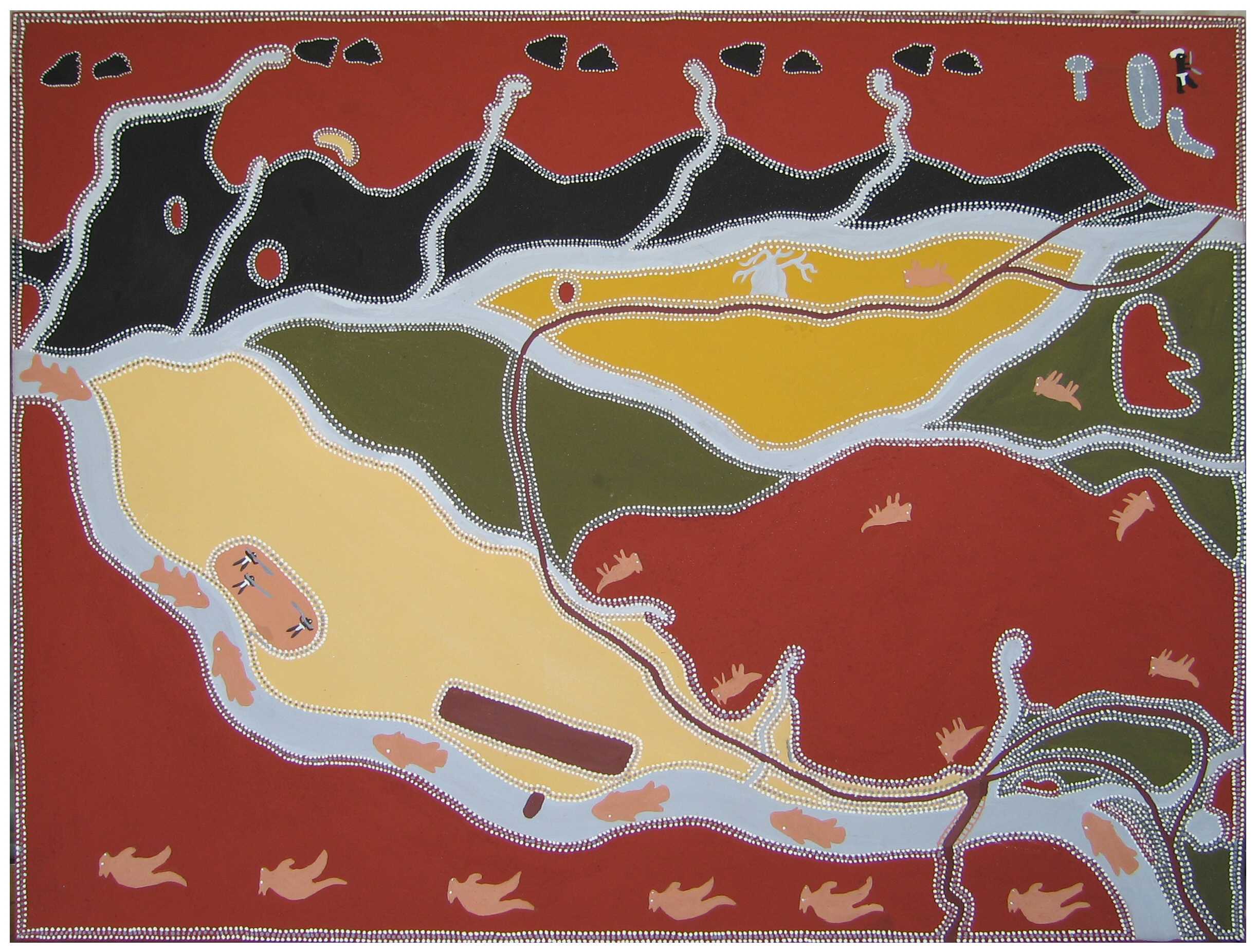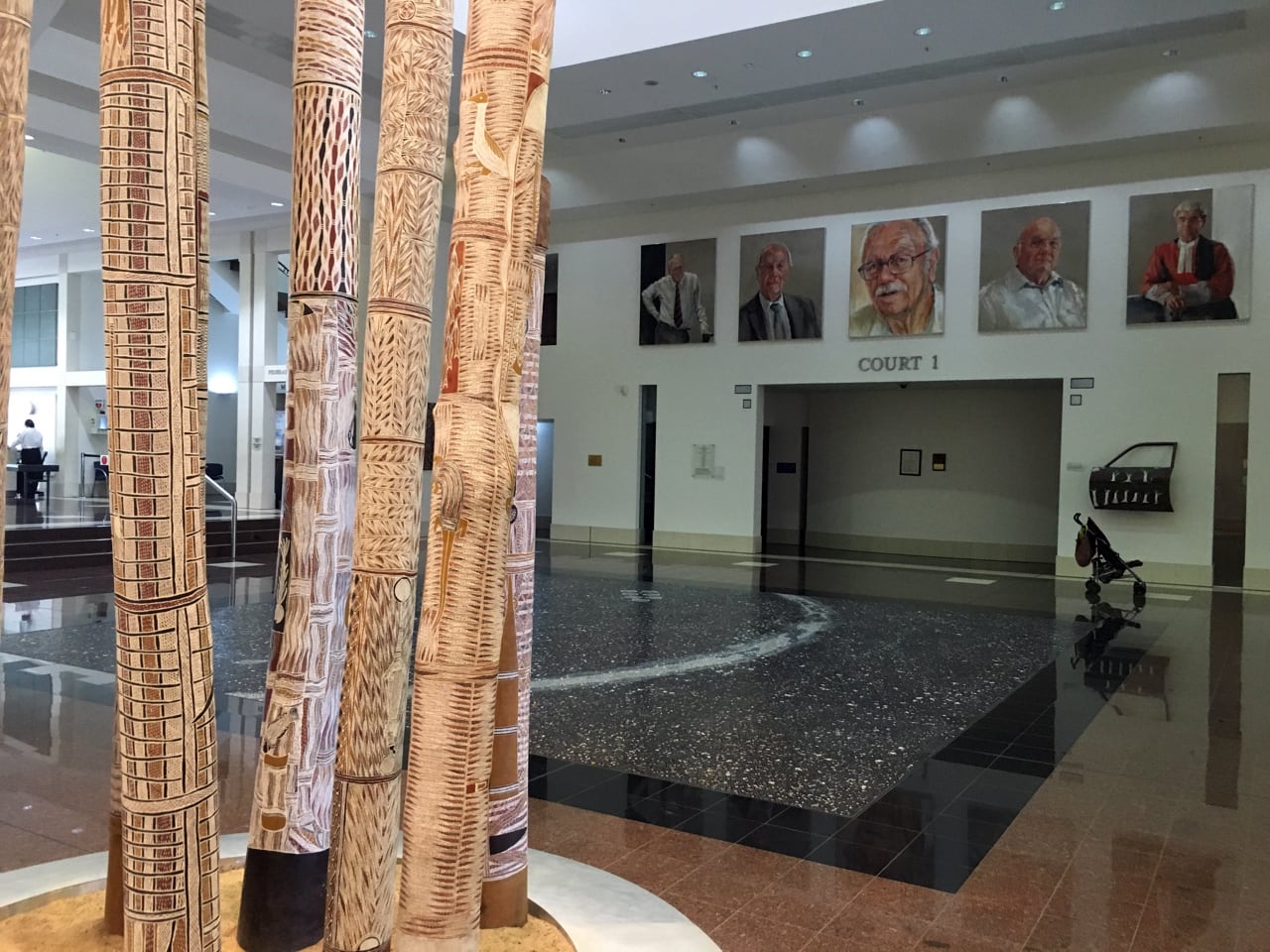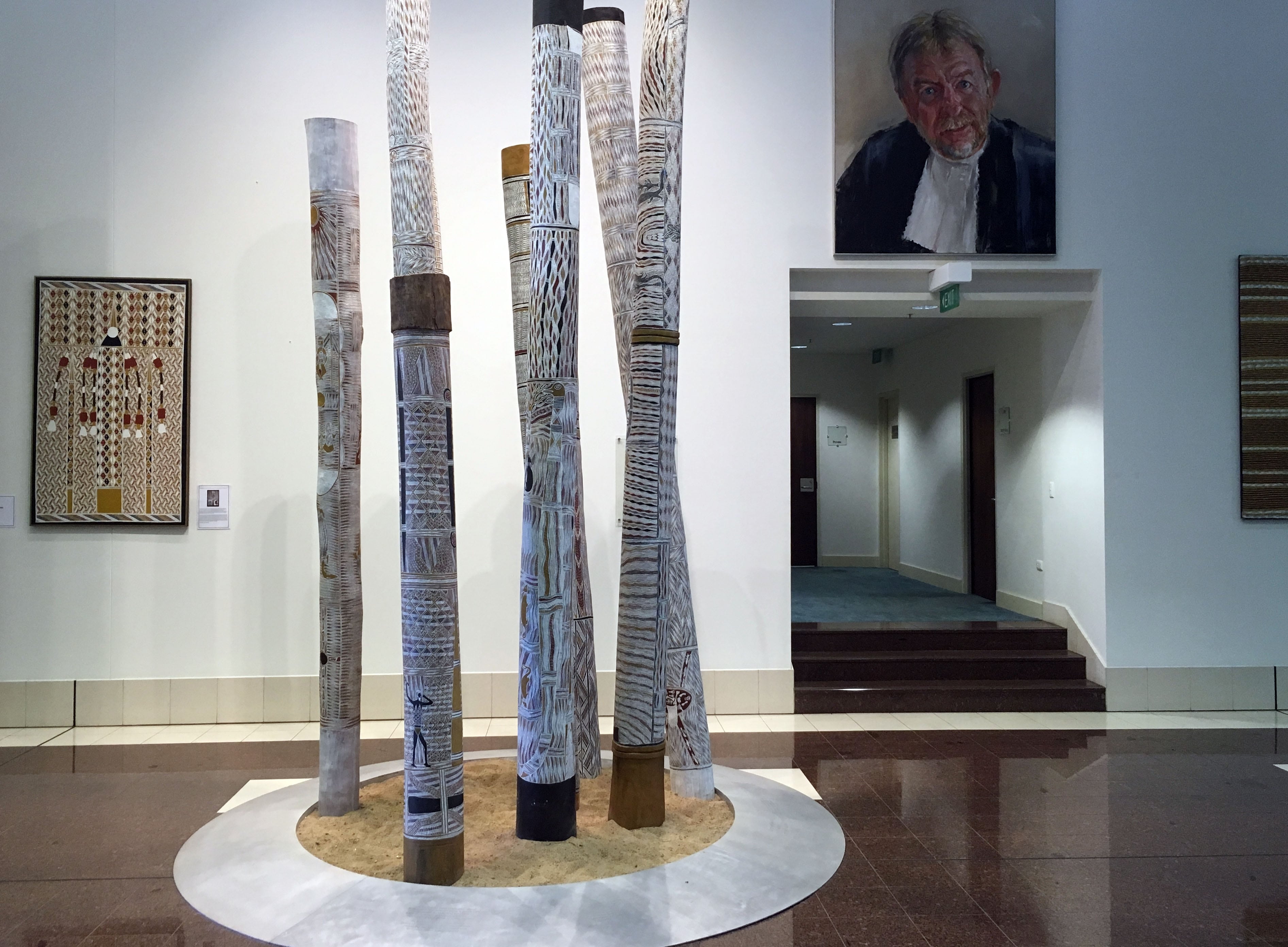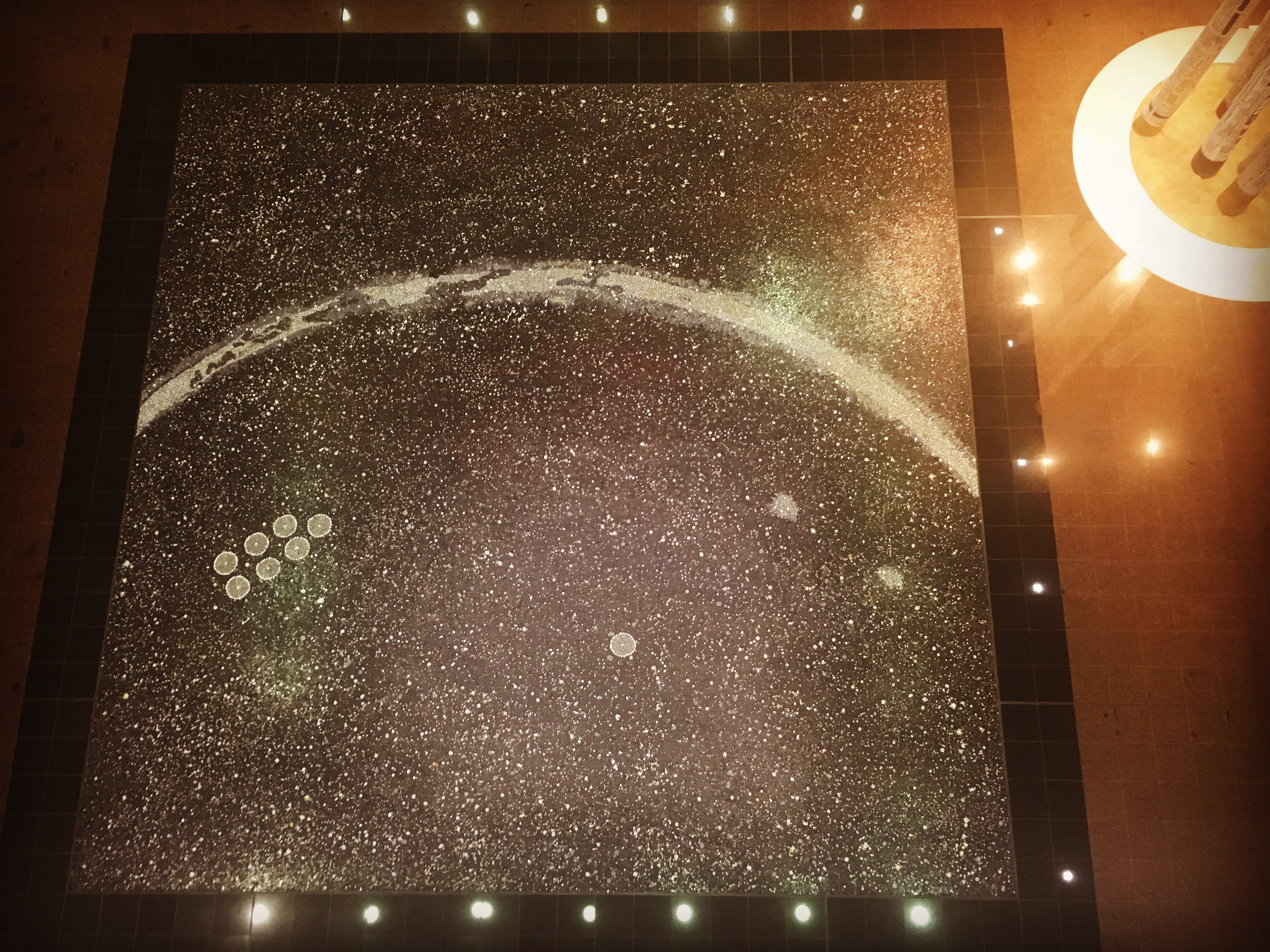



The walls and floors of the Supreme Court in Darwin are filled with works of art that speak of a very clear curatorial intention to illustrate the history of the legal system and its relationship with Aboriginal and Torres Strait Islander people in the Northern Territory. This is an undeniably fraught history and present. The inclusion of works by Aboriginal artists alongside those of non-indigenous artists is an attempt by a colonial authority to reconcile with its subjects.
But even the best intentions fail.
I recently travelled to Larrakia country, on what is now known as Darwin, to listen in on the proceedings of a landmark native title compensation case that involves my in-laws. It is a surreal experience sitting in court listening to non-Indigenous barristers and judges quarrel about how to compensate Nungali and Ngaliwurru people’ s loss of native title around the tiny township of Timber Creek. The outcome of this case will have consequences across Australia. The barristers representing my in-laws, on behalf of the Northern Land Council, are phenomenal in their attempts to bridge two systems of thought and law. Despite these attempts, the commonwealth, state, and territory government’ s legal team’ s efforts seek to perpetually undermine my in-laws’ authority over country. The inherent bias in the system, the structural barriers weighted against native title compensation claims, are confounding, to say the least.
Inside the courtroom, the Northern Land Council Barrister Sturt A. Glacken QC referred to a painting by my father-in-law Alan Griffiths as evidence. Rendered in ochre by a man who knows this country more intimately than anyone, the painting depicts sites that hold cultural, ecological, and historical significance to him. The three judges presiding over the case proceeded to try and locate infrastructure in Timber Creek such as the school, streets and a water tank onto the painting, attempting to grasp specific locations as though the painting were a map. When things didn’ t quite connect in the way they had expected the judges politely asked Glacken if the painting was upside down. He responded by explaining how their question illustrates the very complexity of what we are dealing with,
“This is how Mr Griffiths visualises his world—and it does not translate easily into a euro-western context. The Dreaming cannot be neatly bound.”
Outside the courtroom, in the central hall of the Supreme Court in Darwin, the art continues to illustrate the cross-cultural tension that underpins the legal system’ s inability to reconcile with the universe of this country. Norah Napaljarri’ s Yiwarra Jukurrpa has been rendered in a massive venetian-glass mosaic on the central floor of the building. It is spectacular – even more so when viewed looking down from the top floor. The work details public elements of an otherwise restricted Dreaming story about how the Napaljarri sisters became stars in the night sky. The original painting is also on display. Not far from Napaljarri’ s mosaic are poles from a Wukidi ceremony in memory of the Yolŋu man Dhäkiyarr, which stand erect on a small platform of sand. In the 1930s Dhäkiyarr’ s overturned death sentence, release from prison, and subsequent disappearance (many believe he was killed by friends of the police), illustrate the racial fault lines in Australia’ s legal system. A number of other paintings on canvas and car doors hang at eye level around the hall, providing a glimpse of Aboriginal ceremonies and legal processes across the Northern Territory. Above all of this are six large portraits of Chief Justices—all white men painted by artist Danielle Bergstrom—that in 2011 formed part of a centenary celebration marking 100 years of the court’ s history. There is nothing above these portraits except the spotlights that carefully illuminate their faces.
The legal system’ s structural inability to come to terms with the Aboriginal ‘ other’ is evident in the way that the artworks in the central hall have been arranged. This is how a Euro-western legal system attempts to reconcile with its colonial subjects without compromising its own authority.
But what if a slight curatorial adjustment was made? Imagine if the portraits of these powerful white men were hung at a more humanising eye level. We would see more clearly the frailty of their wrinkles, the set of their mouth, the uncertainty that lies behind all authority. What if the other paintings were placed above these portraits? Suddenly these powerful white men would be sandwiched between the power of Napaljarri’ s Yiwarra Jukurrpa emanating from below and, from above, the weight of the Dreaming, of artworks that pulsate with Aboriginal ceremonies and legal systems, of their histories depicted in vibrant colour applied to canvas, bark, and car doors. The portraits of these Chief Justices would be wedged between the earth and the sky. The structural dynamics at play would suddenly be inverted.
Instead, the current curatorial choices at the Supreme Court in Darwin only reaffirm the enduring colonial power dynamic of the legal system. Which is why their well-intentioned attempt to ‘ welcome everyone’ through art fails.
Australia’ s Eurocentric legal system is still so alien to the Aboriginal people it spends so much time and energy disciplining, and ultimately defining the nature of their rights. As I sit here imagining anthropological studies of government legal teams, of curating the halls of the Supreme Court, I watch people walk past these powerful, often controversial artworks without a second thought. I also imagine a scene where the Aboriginal laws depicted in these works become the dominant legal system; colonial Australia is suddenly at its mercy. In this context a commonwealth barrister would be tasked with the defence of their government’ s actions within the framework of Aboriginal law. What beautiful justice that could bring.
Inverting these power structures, just as one inverts the location of a painting, are simple enough ideas. But the impact could be immeasurable.
Alana Hunt is an artist, writer and cultural producer who lives on Miriwoong country in the remote north-west of Australia.
